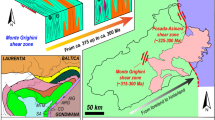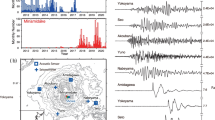Abstract
The Vienna Basin fault system is a slow moving (1–2 mm/y) active sinistral fault extending from the Alps through the Vienna Basin into the Carpathians. It comprises an array of NE-striking sinistral strike-slip segments, which differ both by their kinematic and seismologic properties. Among these, the Lassee segment 30 km east of Vienna is of particular interest for seismic hazard assessment as it shows a significant seismic slip deficit. The segment is located about 8 km from the Roman city of Carnuntum, for which archaeological data indicate a destructive earthquake in the fourth century a.d. (local intensity about 9 EMS-98). Mapping of the Lassee segment using 2D seismic, GPR, tectonic geomorphology and Pleistocene basin analysis shows a negative flower structure at a releasing bend of the Vienna Basin fault. The hanging wall of the flower structure includes a Quaternary basin filled with up to 100-m thick Pleistocene growth strata. Faults root in the basal detachment of the Alpine-Carpathian floor thrust at about 8 km depth. The active faults east of the flower structure offset a Middle Pleistocene terrace of the Danube River forming an up to 20-m high composite fault scarp. High-resolution GPR (40, 500 MHz) mapped at least four distinct surface-breaking faults along this scarp including three faults, which are covered by about 2 m of post-tectonic strata. The youngest fault offsets these strata and coincides with a 0.5-m high scarp. This scarp may be interpreted as the product of a single surface-breaking earthquake, provided that the mapped fault offset formed during coseismic surface rupture. Data indicate that the Lassee segment may well be regarded the source of the fourth century earthquake. The interpretation is in line with local attenuation relations indicating a source close to the damaged site, observed fault dimensions and the fault offsets recorded by GPR and morphology.
















Similar content being viewed by others
References
ACORN (2004) Seismic active discontinuities in the region “Eastern Alps-Western Carpathians-Bohemian Massif” based on geophysical data and digital seismic records of the seismic network “ACORN”. Lenhardt WA (ed) Federal Ministry for Education, Science and Culture, Vienna
Amt der Niederösterreichischen Landesregierung (2007) HADES Bohrdatenbank des geologischen Dienstes. Computerfile, St. Pölten
ASTER (2009) Global digital elevation model (ASTER GDEM). http://www.ersdac.or.jp
Beidinger A, Decker K, Roch KH (2008) Combined geophysical, geomorphological and geological studies at the active Lassee Segment of the Vienna Basin Fault System. YORSGET-08, International Meeting of Young Researchers in Structural Geology and Tectonics, Oviedo, 1–3 July 2008, Programme & Extended Abstracts, pp 207–211
Beidinger A, Decker K, Salcher B (2009) Segmentation of the Vienna Basin Fault System. Seismol Res Lett 80:321
Bus Z, Grenerczy G, Tóth L, Mónus P (2009) Active crustal deformation in two seismogenic zones of the Pannonian region–GPS versus seismological observations. Tectonophysics 474:343–352
Chwatal W, Decker K, Roch KH (2005) Mapping of active capable faults by high-resolution geophysical methods: examples from the central Vienna Basin. Austrian J Earth Sci 97:52–59
Decker K, Peresson H (1998) Miocene to present day tectonics of the Vienna Basin transform fault: Links between the Alps and the Carpathians, Abstracts of the Carpathian -Balkan Geological Association XVI Congress, August 30th to September 2nd: pp 33–36, Vienna (Geologische Bundesanstalt)
Decker K, Peresson H, Hinsch R (2005) Active tectonics and Quaternary basin formation along the Vienna Basin Transform fault. Quat Sci Rev 24:307–322
Decker K, Gangl G, Kandler M (2006) The earthquake of Carnuntum in the 4th century AD–archaeologic results, seismologic scenario and seismo-tectonic implications for the Vienna Basin Fault, Austria. J Seismol 10:479–495
Fink J (1955) Das Marchfeld. Verhandlungen der Geologischen Bundesanstalt. Spec. vol. D: 88–116
Fodor L (1995) From transpression to transtension: Oligocene-Miocene structural evolution of the Vienna Basin and the East Alpine-Western Carpathian junction. Tectonophysics 242:151–182
Fuchs W (1985) Geological map of Austria, No. 61–62, Hainburg an der Donau—Pressburg 1: 50.000. Vienna (Geologische Bundesanstalt)
Grenerczy G (2002) Tectonic processes in the Eurasian-African plate boundary zone revealed by space geodesy. In: Stein S, Freymueller JT (ed) Plate Boundary Zones, AGU Monogr Geodyn Ser 30, pp 67–86
Grenerczy G, Kenyeres A, Fejes I (2000) Present crustal movement and strain distribution in Central Europe inferred from GPS measurements. J Geophys Res 105(B9):21.835–21.846
Grünthal G, Mayer-Rosa D, Lenhardt W (1998) Abschätzung der Erdbebengefährdung für die D-A-CH-Staaten–Deutschland, Österreich, Schweiz. Bautechnik 10:19–33
Hinsch R, Decker K (2003) Do seismic slip deficits indicate an underestimated earthquake potential along the Vienna Basin Transform Fault System? Terra Nova 15(5):343–349
Hinsch R, Decker K (2008) Reassessing seismic-slip values and potential seismogenic fault areas in the Vienna Basin: implications for seismic potential. J Alpine Geol 49:41
Hinsch R, Decker K, Peresson H (2005a) 3-D seismic interpretation and structural modeling in the Vienna Basin: implications for Miocene to recent kinematics. J Austrian Earth Sci 97:38–50
Hinsch R, Decker K, Wagreich M (2005b) 3-D Mapping of segmented active faults in the southern Vienna Basin. Quat Sci Rev 24:321–336
Humer F, Maschek D (2007) Eine Erdbebenzerstörung des 4. Jahrhunderts n. Chr. im sogenannten Peristylhaus der Zivilstadt Carnuntum. Aarchäologie Österreichs 18(2):45–55
Kandler M (1989) Eine Erdbebenkatastrophe in Carnuntum? Acta Archaeologica Academia Scientarum Hungarica 41:313–336
Kandler M, Decker K, Gangl G (2007) Archäologische Befunde von Erdbebenschäden im Raum von Carnuntum und ihre seismotektonische Interpretation. In: Waldherr GH, Smolka A (eds) Antike Erdbeben im alpinen und zirkualpinen Raum. Geographica Historica 24: 111–132
Kelson KI, Baldwin JN (2001) Can paleoseismologic techniques differentiate between aseismic creep and coseismic surface rupture? Seismol Res Lett 72:263
Kröll A, Wessely G (1993) Wiener Becken und angrenzende Gebiete - Strukturkarte-Basis der tertiären Beckenfüllung. Themenkarte der Republik Österreich 1:200000, Vienna (Geologische Bundesanstalt)
Küpper H (1952) Neue Daten zur jüngsten Geschichte des Wiener Beckens. Mitteilungen der Geographischen Gesellschaft 94(1–4):10–30
Lankreijer A, Kovác M, Cloetingh S, Pitonák P, Hloska M, Biermann C (1995) Quantitative subsidence analysis and forward modelling of the Vienna and Danube Basins: thin skinned versus thick skinned extension. Tectonophysics 252:433–451
Lenhardt W, Freudenthaler C, Lipitsch R, Figweil E (2007) Focal-depth distributions in the Austrian Eastern Alps based on macroseismic data. Austrian J Earth Sci 100:66–79
Michetti A, Audermard F, Marco S (2005) Future trends in paleoseismology: integrated study of the seismic landscape as a vital tool in seismic hazard analyses. Tectonophysics 408:3–21
Royden LH (1985) The Vienna Basin: a thin skinned pull apart basin. In: Biddle KT, Christie Blick N (eds) Strike slip deformation, basin formation and sedimentation. SEPM Spec Publ 37: 319–338
Royden LH (1988) Late Cenozoic tectonics of the Pannonian basin system. In: Royden LH, Horváth F (ed) The pannonian basin. A study in basin evolution. Am Assoc Petrol Geol Mem 45: 27–48
Sauer R, Seifert P, Wessely G (1992) Guidbook to excursions in the Vienna Basin and the adjacent Alpine Carpathian thrustbelt in Austria. Mitt Geol Ges 85:1–264
Stenner HD, Ueta K (2000) Looking for evidence of large surface rupturing events on the rapidly creeping southern Calaveras fault, California in Active Fault research for the new millennium. In: Okumura K, Takada K, Goto H (eds) Proceedings of the Hokudan International Symposium and School on the active faulting. Hokudan Co Ltd Hokudan, Japan, pp 479–486
Thenius E (1956) Neue Wirbeltierfunde aus dem Ältestpleistozän von Niederösterreich. Zur Stratifizierung der Donauterrassen. Jahrbuch der Geologischen Bundesanstalt 99:259–271
Vakov AV (1996) Relationship between earthquake magnitude, source geometry and slip mechanism. Tectonophysics 261:97–113
Van Husen D (2000) Geological processes during the Quaternary. Mitt Österr Geol Ges 92:135–156
Wells DL, Coppersmith KJ (1994) New empirical relationships among magnitude, rupture length, rupture width, rupture area, and surface displacement. Bull Seismol Soc Am 84:974–1002
Wessely G (1988) Structure and development of the Vienna Basin in Austria. In: Royden LH, Horváth F (ed) The Pannonian Basin. A study in basin evolution. Am Assoc Petrol Geol Mem 45: 333–346
Wessely G (1993) Geologischer Tiefbau Wiener Becken - Molasse Niederösterreichs, In: Brix F, Schulz O (ed) Erdöl und Erdgas in Österreich. Verlag Nat Hist Museum Wien und Berger Horn
ZAMG [Zentralanstalt für Meteorologie und Geodynamik] (2008) Catalogue of felt earthquakes in Austria 1201–2008. Computer file, Vienna
Acknowledgments
We gratefully acknowledge the fruitful discussions with Wolfgang Lenhardt on seismological issues, Bernhard Salcher on Pleistocene stratigraphy and geomorphology, Monika Hölzel, Maria Hoprich and Andras Zamolyi. Ralph Hinsch improved style and quality of the manuscript. We are further in debt to OMV Austria (Christian Astl and Phil Strauss) for providing access to the seismic subcrop data. Seismic processing used the Landmark Geographix University Grant to the University of Vienna.
Author information
Authors and Affiliations
Corresponding author
Rights and permissions
About this article
Cite this article
Beidinger, A., Decker, K. & Roch, K.H. The Lassee segment of the Vienna Basin fault system as a potential source of the earthquake of Carnuntum in the fourth century a.d. . Int J Earth Sci (Geol Rundsch) 100, 1315–1329 (2011). https://doi.org/10.1007/s00531-010-0546-x
Received:
Accepted:
Published:
Issue Date:
DOI: https://doi.org/10.1007/s00531-010-0546-x




